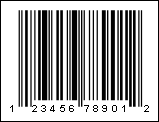UPC-A was the first barcode, created by Uniform Code Council, Inc. in 1973. The UPC-A barcode is an unbroken code with a fixed length and high density. It is used for tracking trade items in stores, and otherwise marking goods.
Valid symbols: |
0123456789 |
Length: |
fixed, 12 characters |
Check digit: |
one, modulo-10 algorithm |
UPC-A barcodes consist of 11 data digits and one check digit. The first digit is a number system digit that normally represents the type of product being identified. The following 5 digits are a manufacturers code and the next 5 digits are used to identify a specific product.
The barcode contains the following elements:
![]() 1 digit - system number.
1 digit - system number.
![]() 5 digits - manufacturer code.
5 digits - manufacturer code.
![]() 5 digits - product code.
5 digits - product code.
![]() 1 digit - check digit.
1 digit - check digit.
The barcode does not contain any information about characteristics of a product, but only a unique number relating to an entry in the International data base where all information about the particular product is stored. An example barcode in UPC-A format:

UPC-A Barcode
Note the 'human readable' digits at the foot which can be used by operators if the label becomes damaged or will not scan for some reason - "123456789012" is the number encoded in the barcode.